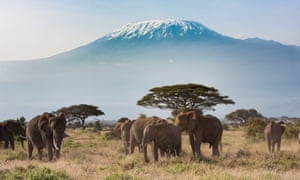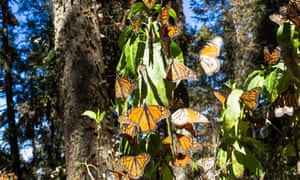https://www.theguardian.com/environment/2017/nov/13/from-the-everglades-to-kilimanjaro-climate-change-is-destroying-world-wonders
From the Everglades in the US to the Great Barrier Reef in Australia, climate change is destroying the many of the greatest wonders of the natural world.
A new report on Monday from the International Union for Conservation of Nature(IUCN) reveals that the number of natural world heritage sites being damaged and at risk from global warming has almost doubled to 62 in the past three years.
Those at high risk include iconic places from the Galapagos Islands to the central Amazon and less well known but equally vibrant and unique sites such as the karst caves of Hungary and Slovakia and the monarch butterfly reserves in Mexico.
Coral reefs are particularly badly affected by rising ocean temperatures, from the Seychelles to Belize, where the northern hemisphere’s biggest reef is situated. Global heating is also causing mountain glaciers to rapidly shrink, from Kilimanjaro in Tanzania to the Rocky Mountains in Canada and the Swiss Alps Jungfrau-Aletsch – home to the largest Alpine glacier.
Other ecosystems being damaged are wetlands, such as the Everglades, where sea level is rising as the ocean warms and salt water is intruding. In the Sundarbans mangrove forest on the delta of the Ganges, Brahmaputra and Meghna rivers on the Bay of Bengal, two islands have already been submerged and a dozen more are threatened. Fiercer storms are also increasing the risk of devastation.
Rising numbers of wildfires are damaging the beautiful Fynbos flowerscapes in the Cape region of South Africa and the Monarch butterfly site in Mexico. Elsewhere, warming is melting the permafrost in the newly declared Qinghai Hoh Xil heritage site, which is at 4,500m altitude in the Qinghai-Tibetan Plateau.
Australia is especially exposed as it has 10 natural heritage sites where climate change damage is rated as high or very high risk, from its Gondwana rainforests to Shark Bay in western Australia and islands such as Fraser and Macquarie.
The new IUCN report was launched at the UN climate summit being held in Bonn, Germany, where the world’s nations are working to put the 2015 landmark Paris agreement into operation.
“Protection of world heritage sites is an international responsibility of the same governments that have signed up to the Paris agreement,” said Inger Andersen, IUCN director general. “This report sends them a clear message: climate change acts fast and is not sparing the finest treasures of our planet. This underlines the need for urgent and ambitious national commitments and actions to implement the Paris agreement.”
Climate change is one of a range of factors that mean about a third of the world’s 241 natural heritage sites are being damaged, with invasive alien species being the top threat. Then, after global warming, comes unsustainable tourism, followed by other problems like poaching and construction.
Prince Charles, the UK’s heir to the throne and longtime environmentalist, said: “Climate change is in actual fact becoming regarded as the fastest growing threat, its impacts already visible in many of the sites. This report highlights the incredibly urgent need to expedite the global response to climate change.” A further 55 sites around the world are expected to be harmed by climate change in the future unless warming is curbed.
“Natural world heritage sites also play a crucial role supporting local economies and livelihoods,” said Tim Badman, director of IUCN’s World Heritage Programme. “Their destruction can thus have devastating consequences that go beyond their exceptional beauty and natural value. In Peru’s Huascarán national park, for example, melting glaciers affect [people’s] water supplies.”
The report does include some success stories, showing that the destruction of nature’s most precious sites can be tackled. In Ivory Coast’s Comoé national park, for example, elephant and chimpanzee populations have recovered thanks to better management and international support after the end of conflicts.
But overall, the number of sites with good status has fallen, leaving Andersen to ask: “If we cannot secure the highest quality protection for the world’s most precious natural areas, what will this say about our ability to fulfil our collective commitments towards the planet, including the Paris agreement?”
• This article was corrected on 13 Nov 2017. We mistakenly said Kilimanjaro was in Kenya rather than Tanzania.
Since you’re here …
… we have a small favour to ask. More people are reading the Guardian than ever but advertising revenues across the media are falling fast. And unlike many news organisations, we haven’t put up a paywall – we want to keep our journalism as open as we can. So you can see why we need to ask for your help. The Guardian’s independent, investigative journalism takes a lot of time, money and hard work to produce. But we do it because we believe our perspective matters – because it might well be your perspective, too.
I appreciate there not being a paywall: it is more democratic for the media to be available for all and not a commodity to be purchased by a few. I’m happy to make a contribution so others with less means still have access to information.Thomasine F-R.
If everyone who reads our reporting, who likes it, helps fund it, our future would be much more secure. For as little as £1, you can support the Guardian – and it only takes a minute. Thank you.




沒有留言:
張貼留言